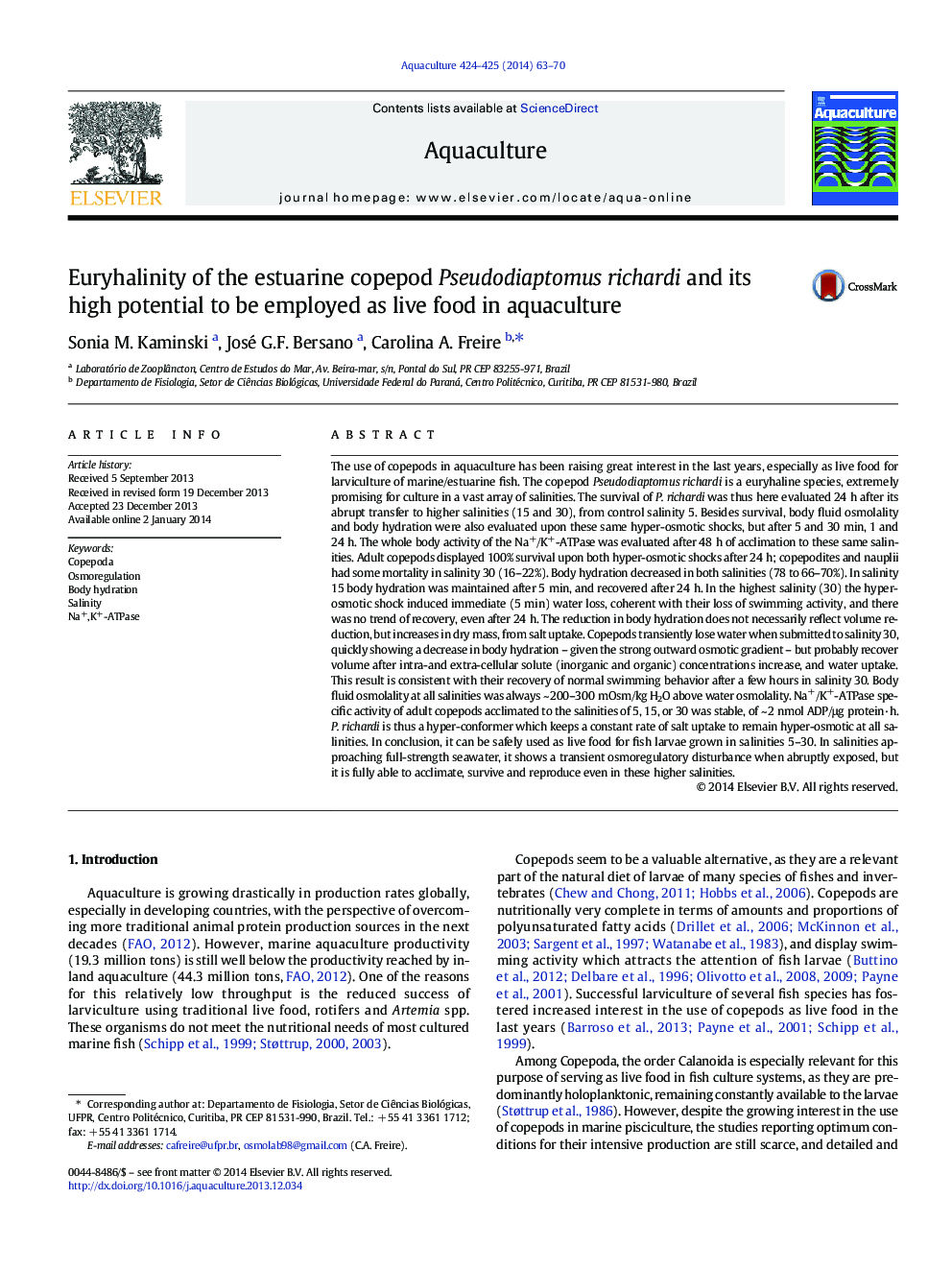| کد مقاله | کد نشریه | سال انتشار | مقاله انگلیسی | نسخه تمام متن |
|---|---|---|---|---|
| 8495253 | 1552860 | 2014 | 8 صفحه PDF | دانلود رایگان |
عنوان انگلیسی مقاله ISI
Euryhalinity of the estuarine copepod Pseudodiaptomus richardi and its high potential to be employed as live food in aquaculture
دانلود مقاله + سفارش ترجمه
دانلود مقاله ISI انگلیسی
رایگان برای ایرانیان
کلمات کلیدی
موضوعات مرتبط
علوم زیستی و بیوفناوری
علوم کشاورزی و بیولوژیک
علوم آبزیان
پیش نمایش صفحه اول مقاله

چکیده انگلیسی
The use of copepods in aquaculture has been raising great interest in the last years, especially as live food for larviculture of marine/estuarine fish. The copepod Pseudodiaptomus richardi is a euryhaline species, extremely promising for culture in a vast array of salinities. The survival of P. richardi was thus here evaluated 24 h after its abrupt transfer to higher salinities (15 and 30), from control salinity 5. Besides survival, body fluid osmolality and body hydration were also evaluated upon these same hyper-osmotic shocks, but after 5 and 30 min, 1 and 24 h. The whole body activity of the Na+/K+-ATPase was evaluated after 48 h of acclimation to these same salinities. Adult copepods displayed 100% survival upon both hyper-osmotic shocks after 24 h; copepodites and nauplii had some mortality in salinity 30 (16-22%). Body hydration decreased in both salinities (78 to 66-70%). In salinity 15 body hydration was maintained after 5 min, and recovered after 24 h. In the highest salinity (30) the hyper-osmotic shock induced immediate (5 min) water loss, coherent with their loss of swimming activity, and there was no trend of recovery, even after 24 h. The reduction in body hydration does not necessarily reflect volume reduction, but increases in dry mass, from salt uptake. Copepods transiently lose water when submitted to salinity 30, quickly showing a decrease in body hydration - given the strong outward osmotic gradient - but probably recover volume after intra-and extra-cellular solute (inorganic and organic) concentrations increase, and water uptake. This result is consistent with their recovery of normal swimming behavior after a few hours in salinity 30. Body fluid osmolality at all salinities was always ~ 200-300 mOsm/kg H2O above water osmolality. Na+/K+-ATPase specific activity of adult copepods acclimated to the salinities of 5, 15, or 30 was stable, of ~ 2 nmol ADP/μg protein·h. P. richardi is thus a hyper-conformer which keeps a constant rate of salt uptake to remain hyper-osmotic at all salinities. In conclusion, it can be safely used as live food for fish larvae grown in salinities 5-30. In salinities approaching full-strength seawater, it shows a transient osmoregulatory disturbance when abruptly exposed, but it is fully able to acclimate, survive and reproduce even in these higher salinities.
ناشر
Database: Elsevier - ScienceDirect (ساینس دایرکت)
Journal: Aquaculture - Volumes 424â425, 20 March 2014, Pages 63-70
Journal: Aquaculture - Volumes 424â425, 20 March 2014, Pages 63-70
نویسندگان
Sonia M. Kaminski, José G.F. Bersano, Carolina A. Freire,